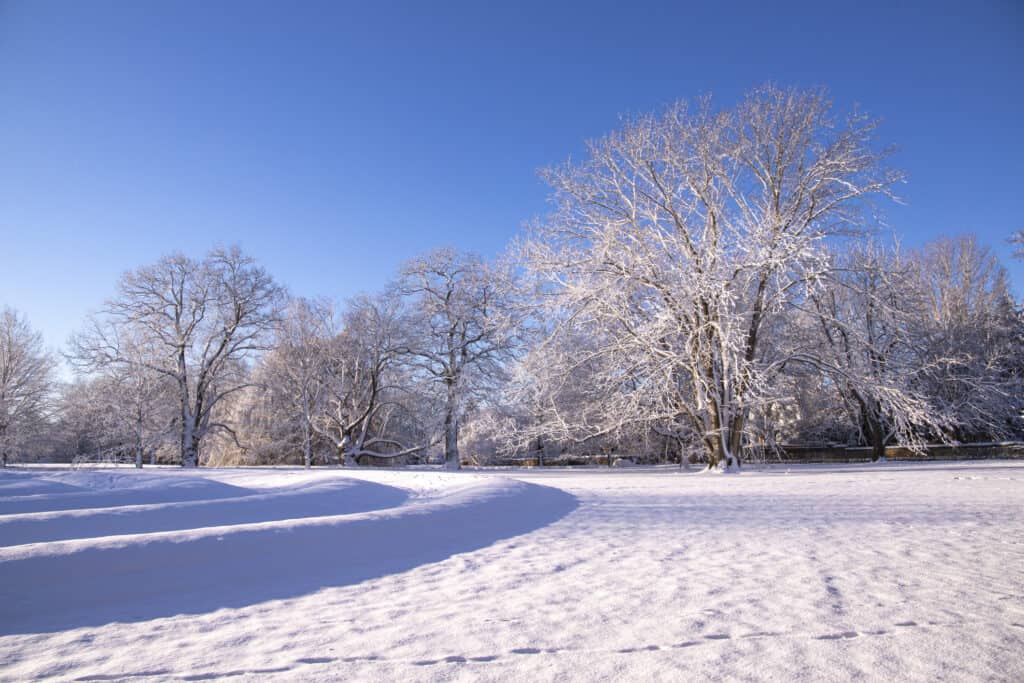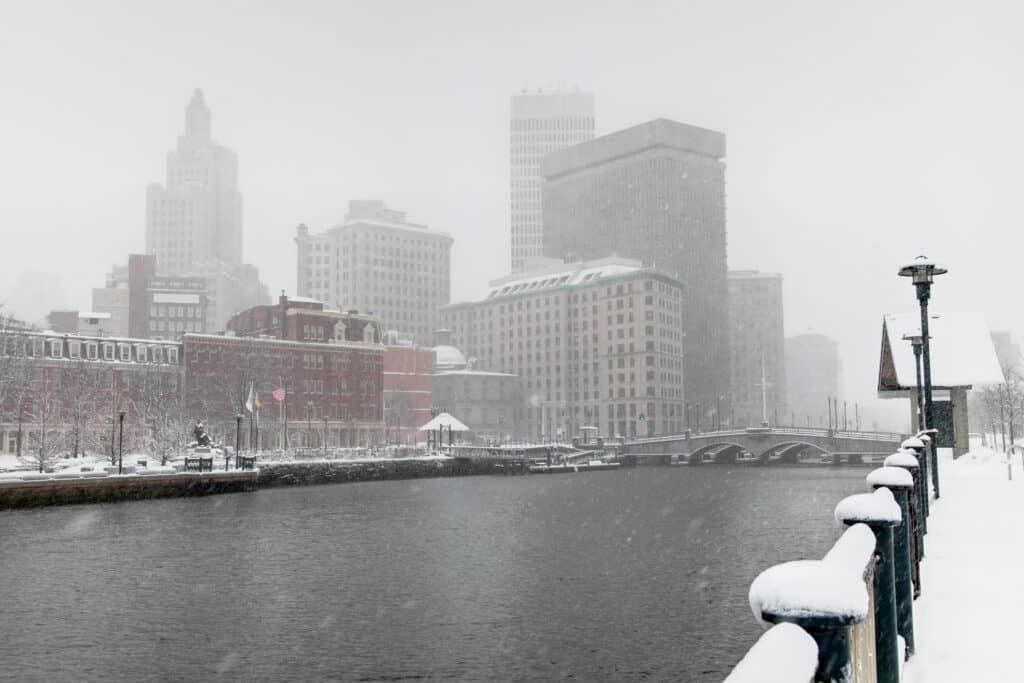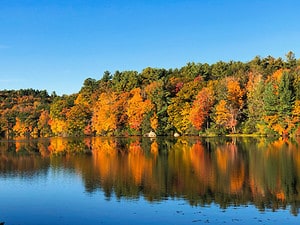Although Rhode Island is the smallest state in the United States, it still receives a notable amount of annual snowfall. The northwest portion of Rhode Island experiences the most amount of snow due to higher elevations and distance from the coast, but even southern parts have received abundant amounts of snow as coastal nor’easters attack New England year in and year out.
Understanding Snowfall in Rhode Island
Rhode Island is divided into three sectors, and each sector experiences snowfall differently in comparison with the others. From the coast to northwest, the elevation within Rhode Island gradually increases. The highest elevation within Rhode Island measures 800 feet. Therefore, higher elevations in the northwest will experience more snowfall than central and southeast portions of the state.
Climate in Rhode Island is subject to variability. Weather can change day-to-day, so it is difficult to predict what forms the temperature and weather might take in each month. In fact, stable weather patterns within Rhode Island are out of the norm.
One aspect that does maintain stability, though, is precipitation. Precipitation in Rhode Island, overall, is scattered evenly across the entire state. Large amounts of precipitation come from storms that advance along the Atlantic coast. Rhode Island averages 42 to 46 inches of annual precipitation. Northwest Rhode Island can experience more precipitation than the rest of the state, but the amount only differs by about an eight-inch increase.
However, snowfall is a different story. Areas in the southeast average 20 inches of annual snowfall. Moving northwest, the number increases. Northwest regions can receive between 40 and 55 inches of snowfall in a season. Other areas receive 25 to 30 inches each year. These averages are subject to the season, though. While harsh winters bring plentiful amounts of snow, milder ones can decrease these averages greatly.

Snow blankets the seaside city of Newport, Rhode Island in winter.
©iStock.com/Veronica Bruno
Temperature in Rhode Island
Temperature averages in Rhode Island range between 48ºF and 51ºF year-round. In January and February, temperature averages sit around 19ºF and 20ºF. However, in coastal regions, temperature means are approximately 25ºF. On the coast, only one day a year does temperature reach below 0ºF. The remainder of the time, temperatures stay above freezing. Temperatures on the coast measure below 32ºF on only about 20 to 25 days during the year. In Southwest Rhode Island, just off the coast, anywhere from six to eight days a year can experience temperatures below 0ºF. This only occurs during an exceptionally cold month in winter. In the rest of Rhode Island, temperatures below freezing strike approximately 30 to 40 days annually. Average monthly temperature ranges for a snow season in Rhode Island are described by the table below.
| December | January | February | March | |
|---|---|---|---|---|
| Highs (ºF) | 45 | 40 | 40 | 49 |
| Lows (ºF) | 25 | 17 | 24 | 31 |
Earliest First Snow Ever Recorded
The earliest snowfall to ever reach Rhode Island occurred on October 19, 1972 in Providence. Only 0.7 inches fell, but the amount was still considered measurable. The average date for a first snow in Providence, Rhode Island is December 1, so to have a first snow six weeks prior is astounding! In the last decade, the earliest snow in Rhode Island fell just in time for spooky season on October 30, 2020 and measured 1.6 inches.
Latest First Snow Ever Recorded
The latest first snow within the last decade occurred in Providence on December 29, 2015, which is 28 days past the average date of December 1. The December 29 snow left 0.6 inches of powder on the ground. While Rhode Islanders missed out on a white Christmas in 2015, at least the harsh brutalities of a New England winter were postponed for a time.
Description of First Snowfalls in Rhode Island
Snowfall in Rhode Island occurs between the months of December and March. Although, some weather reports have recorded snowfall in October and November. Due to the unpredictable weather patterns within the state, snowfall, precipitation, and temperature estimates are subject to change at any given time. Providence, Rhode Island typically averages 36.6 inches of annual snowfall. However, in 2021, Providence received 43.5 inches of snow throughout the winter season.
In December, snowfall ranges between seven and 13 inches at the beginning of the snow season. Snowfall begins to pick up in January. For instance, Providence averages nine inches of snow during January. February snowfall in Southern Rhode Island and Northern Rhode Island averages seven inches and 12 inches, respectively. Heading into spring, the month of March averages snowfall between four inches and 12 inches, according to the region.

Providence, Rhode Island typically averages 36.6 inches of annual snowfall.
©iStock.com/DenisTangneyJr
Biggest Snowfall in Rhode Island
The snowiest part of the state is North Foster, Rhode Island. Although North Foster is a tiny town within Providence County, it reports abundant snowfall. The town averages 57.1 inches of snow annually. However, the largest amount of snow to fall in one stroke in Rhode Island did not affect North Foster. Woonsocket, Rhode Island saw 38 inches of snow during the Blizzard of 1978.
Blizzards in Rhode Island
Although Rhode Island may not experience as much snowfall as its New England neighbors due to its position on the coast, the state has still received some striking snowstorms. Over the last 60 years alone, Providence, Rhode Island has been faced with 10 blizzards ranging between 17 and 29 inches of accumulated snow.
Blizzard of 1978
The Blizzard of 1978 happened between the dates of February and February 7. It was a coastal nor’easter that dumped 27.6 inches of snow on Providence, Rhode Island. Even more impressive, 38 inches of snow was recorded in Woonsocket, Rhode Island. Unfortunately, 26 people died because of the storm.
Winter Storm Nemo
While most individuals might associate Nemo with an innocent looking clownfish from Pixar’s Finding Nemo, the blizzard that hit Rhode Island in 2013 was anything but innocent. Between February 7 and 18, snowfall ranging from 18 to 24 inches covered Rhode Island, and approximately 180,000 businesses and homes lost power.
The Great Blizzard of 1888
The Great Blizzard of 1888 was also known as The Great White Hurricane. The snowstorm affected the entire Northeast region of the United States, leaving New England buried for days on end. Between March 11 and March 14 of 1888, The Great White Hurricane brought 20 inches of snow to Kingston, Rhode Island. While the entirety of the state was affected, Kingston received the most snowfall.
April Fool’s Day Blizzard
Although some may have thought weather predictions in 1997 to be but an April Fool’s joke, March 30 and April 1 brought 18 inches of snow to Providence, Rhode Island. In Northwest regions of the state, figures between 20 and 30 inches of snowfall were recorded.

Although Rhode Island may not experience as much snowfall as New England it has experienced its fair share of blizzards.
©Gary Brownell / Flickr – License
The Best Places to Enjoy Snow in Rhode Island
While most northeastern states feature an array of skiing opportunities, Rhode Island has only one ski area within the state. This fact shouldn’t turn a vacationer away, though, because plenty of other opportunities for appreciating winter weather exist. Activities like ice skating, sledding, and snowshoeing are some of the best ways to enjoy the snow in Rhode Island.
Yawgoo Valley Ski Area and Water Park
Yawgoo Valley is the only ski area in Rhode Island, but it highlights other snow activities, too. It is open from December to March possesses 36 acres and numerous trails dedicated to skiing and snowboarding alone. Snow tubing is available to visitors on the weekends. Skiing and snowboarding equipment can be leased, or a visitor can bring their own!
Pulaski State Park and Recreational Area
Pulaski State Park and Recreational Area has 10 miles of ski trails available to cross country skiers. Not looking to ski? The area also provides opportunities for hiking and picnicking. Overall, there are a plethora of ways to savor the snowfall within Pulaski State Park and Recreational Area.
Up Next
The photo featured at the top of this post is © iStock.com/nikon401
Sources
- Steven Matregrano, Available here: https://www.wpri.com/weather/weather-blog/when-could-ri-see-its-first-measurable-snowfall/#:~:text=The%20earliest%20snowfall%20Providence%20has,saw%200.6%20inches%20of%20snow
- State of Rhode Island Department of Environmental Management, Available here: https://dem.ri.gov/climate/climate-overview-ri.php
- Does It Snow In, Available here: https://doesitsnowin.com/rhode-island/
- Melanie DaSilva, Available here: https://www.wpri.com/weather/winter-weather/here-are-the-top-10-biggest-snowstorms-ever-to-hit-rhode-island/
- Go Local Prov, Available here: https://www.golocalprov.com/news/the-10-greatest-blizzards-in-rhode-island-history
- Visit Rhode Island, Available here: https://www.visitrhodeisland.com/things-to-do/parks-recreation/winter-recreation/
FAQs (Frequently Asked Questions)
How many inches of snow does Rhode Island receive?
Rhode Island snowfall varies by region. While the southeast portion of Rhode Island averages 20 inches of annual snowfall, regions northwest can accumulate up to 50 inches of snowfall in a year!
During which months does it snow in Rhode Island?
Snow in Rhode Island typically begins around December 1st and ends in March.
What is the snowiest month in Rhode Island?
January is the snowiest month in Rhode Island, averaging nine inches of snow in Providence. However, some places can receive up to a foot of snow into the month of February!
Thank you for reading! Have some feedback for us? Contact the AZ Animals editorial team.






